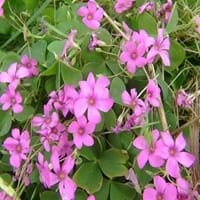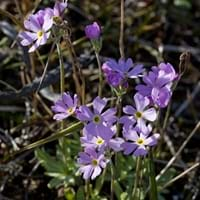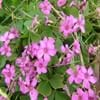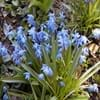Life Span
Perennial
Perennial
Type
Bulb or Corm or Tuber
Perennial
Origin
South America, Argentina, Brazil
Northeastern United States, Mid-Atlantic United States, Southeastern United States, North-Central United States, Central United States, South-Central United States
Types
Oxalis acetosella
Oxalis adenophylla
Oxalis albicans
Oxalis alpina
Not Available
Habitat
Deep, Hardwood forests
Roadsides, sand dunes, Waste areas
USDA Hardiness Zone
7-9
5-8
Sunset Zone
21,22
1a, 1b, 2a, 2b, 3a, 3b, 4, 5, 6, 7, 8, 9, 10, 11, 12, 13, 14, 15, 16, 17, 18, 19, 20, 21, 22, 23, 24
Habit
Clump-Forming
Clump-Forming
Flower Color
Pink, Light Pink, Rose
White, Ivory
Flower Color Modifier
Bicolor
Bicolor
Leaf Color in Spring
Green, Light Green
Green
Leaf Color in Summer
Light Green
Green
Leaf Color in Fall
Several shades of Green
Green
Leaf Color in Winter
Light Green
Light Green
Leaf Shape
Obcordate
Oblong
Plant Season
Spring, Summer, Fall
Summer
Sunlight
Full Sun, Partial Sun
Full Sun, Partial Sun
Growth Rate
Medium
Medium
Type of Soil
Loam, Sand
Loam, Sand
The pH of Soil
Acidic, Neutral
Acidic, Neutral, Alkaline
Soil Drainage
Well drained
Well drained
Bloom Time
Spring, Late Spring, Early Summer, Summer, Late Summer, Early Fall, Fall
Early Summer, Summer, Late Summer
Tolerances
Drought
Variety of soil types
Where to Plant?
Ground
Container, Ground, Pot
How to Plant?
Corms or bulbs, From Rhizomes
Divison, Seedlings, Stem Planting
Plant Maintenance
Medium
Low
Watering Requirements
Needs more water during establishment, Water Deeply, Water in morning to avoid prompting diseases
Average Water Needs, Do Not over Water, Never Over-water, Requires regular watering, Water more in summer
In Summer
Lots of watering
Lots of watering
In Spring
Moderate
Moderate
In Winter
Average Water
Average Water
Soil pH
Acidic, Neutral
Acidic, Neutral, Alkaline
Soil Type
Loam, Sand
Loam, Sand
Soil Drainage Capacity
Well drained
Well drained
Sun Exposure
Full Sun, Partial Sun
Full Sun, Partial Sun
Pruning
Cut or pinch the stems, Pinch Tips, Pinching, Remove damaged leaves, Remove dead branches, Remove dead leaves
Remove damaged leaves, Remove dead branches, Remove dead leaves, Remove dead or diseased plant parts
Fertilizers
All-Purpose Liquid Fertilizer, Apply N-P-K
All-Purpose Liquid Fertilizer, fertilize in growing season
Pests and Diseases
Not Available, Red blotch
Slugs, Snails
Plant Tolerance
Drought, Shade areas
Variety of soil types
Flower Petal Number
Single
Single
Foliage Texture
Medium
Fine
Foliage Sheen
Matte
Matte
Attracts
Not Available
Insects
Allergy
Not Available
Abdominal pain, Constipation, Diarrhea, Skin irritation
Aesthetic Uses
Beautification, Cottage Garden, Showy Purposes
Beautification, Borders, Landscape Designing, Showy Purposes
Beauty Benefits
Not Available
Good for skin, Making cosmetics, Stops hair loss
Environmental Uses
Air purification
Air purification, Food for insects, Versatility
Medicinal Uses
Not Available
Eczema
Part of Plant Used
Flowers
Root
Other Uses
Not Available
Decoration Purposes, Medicinal oil, Showy Purposes, Used as Ornamental plant, Used for its medicinal properties
Used As Indoor Plant
No
Yes
Used As Outdoor Plant
Yes
Yes
Garden Design
Container, Groundcover, Mixed Border, Rock Garden / Wall, Wildflower
Edging, Feature Plant, Groundcover, Mixed Border
Botanical Name
OXALIS articulata
Primula mistassinica
Common Name
Sorrel, Wood Sorrel
Mistassini primrose, Lake Mistassini primrose, bird's-eye primrose
In Hindi
sorrel
Mistassini Primrose
In German
Sauerampfer
Mistassini Primrose
In French
oseille
Primrose Mistassini
In Spanish
alazán
Mistassini Primrose
In Greek
οξαλίδα
Mistassini Primrose
In Portuguese
alazão
Mistassini Primrose
In Polish
szczaw
Mistassini Primrose
In Latin
varii,
Mistassini Primrose
Phylum
Tracheophyta
Magnoliophyta
Class
Magnoliopsida
Magnoliopsida
Order
Oxalidales
Myrtales
Family
Oxalidaceae
Onagraceae
Clade
Angiosperms, Eudicots, Rosids
Angiosperms, Eudicots, Rosids
Tribe
Not Available
Onagreae
Subfamily
Not Available
Onagroideae
Importance of Sorrel and Mistassini Primrose
Want to have the most appropriate plant for your garden? You might want to know the importance of Sorrel and Mistassini Primrose. Basically, these two plants vary in many aspects. Compare Sorrel and Mistassini Primrose as they differ in many characteristics such as their life, care, benefits, facts, etc. Every gardener must at least have the slightest clue about the plants he wants to plant in his garden. Compare their benefits, which differ in many ways like facts and uses. The medicinal use of Sorrel is Not Available whereas of Mistassini Primrose is Eczema. Sorrel has beauty benefits as follows: Not Available while Mistassini Primrose has beauty benefits as follows: Not Available.
Compare Facts of Sorrel vs Mistassini Primrose
How to choose the best garden plant for your garden depending upon its facts? Here garden plant comparison will help you to solve this query. Compare the facts of Sorrel vs Mistassini Primrose and know which one to choose. As garden plants have benefits and other uses, allergy is also a major drawback of plants for some people. Allergic reactions of Sorrel are Not Available whereas of Mistassini Primrose have Abdominal pain, Constipation, Diarrhea and Skin irritation respectively. Having a fruit bearing plant in your garden can be a plus point of your garden. Sorrel has no showy fruits and Mistassini Primrose has no showy fruits. Also Sorrel is not flowering and Mistassini Primrose is flowering. You can compare Sorrel and Mistassini Primrose facts and facts of other plants too.





